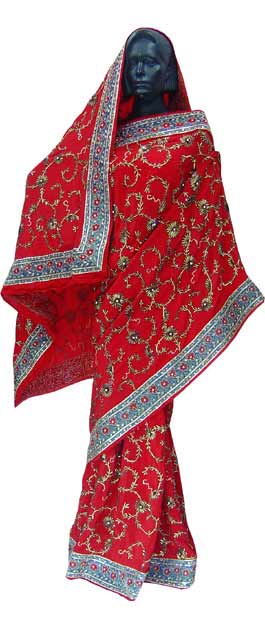Beautiful Sarees Biogarphy
Source(google.com.pk)India has also a rich and varied culture of silk as China and Japan have. The civilization of Harappa and Mohenjo Daro is very famous all over the world. About 4000 years ago these people had lived vary rich culture and aware of using dye with madder, who did not confine to be in one place but travel to other places on sea roots. The India’s rich and complex textile history goes back as old as 15th century which was also famous for sculpture and paintings. Unlike the other countries the silk history of India is different. The climatic conditions and geographical features contribute a lot for its evolutions. The indigenously produced silk moths, whose cocoons give silk thread, that is mostly suited for weaving are grown widely.
Silk was used mostly because it was considered to be pure which need not be washed. For Party, luxury and elegance finely woven silk was given more importance. There is another type of silk wherein one does not have to end the life of a cocoon of whose of whose fiber is fallen out after it is dead. The silk garments produced under this process are used by the Jains and orthodox Brahmins who believes in that this process is the best, since killing of the insect is not done for obtaining the silk.
SARI AT THE CENTER OF SILK WEAVING TRADITION
The present day silk weaving tradition in India revolves around sari, an ethnic dress that is worn in most parts of the country. The combination of shine and the glamour associated with silk has led to the creation of a myriad of traditional sari styles, with each region lending its unique flavor to Indian ethnicity.
Silk saris are often created with zari (fabric woven with thin gold and silver wires) work on them. The main silk weaving centers are Banaras, Surat, Chander, Murshidabad, Mysore, Assam, Kanchepuram, Tanjore, Dharmavaram etc.
The present day silk weaving tradition in India revolves around sari, an ethnic dress that is worn in most parts of the country. The combination of shine and the glamour associated with silk has led to the creation of a myriad of traditional sari styles, with each region lending its unique flavor to Indian ethnicity.
Silk saris are often created with zari (fabric woven with thin gold and silver wires) work on them. The main silk weaving centers are Banaras, Surat, Chander, Murshidabad, Mysore, Assam, Kanchepuram, Tanjore, Dharmavaram etc. A silk sari is also described as smart fabric sari.
Today silk is not just restricted to saris. A wide range of ladies' and men's wear like dupattas, garments, fabrics, caps, handkerchiefs, scarves, dhotis, turbans, shawls, ghagras or lehengas, and even quilts, bedcovers, cushions, table-cloths curtains are made of silk.
Beautiful Sarees Wallpaper Photos Pictures Pics Images 2013

Beautiful Sarees Wallpaper Photos Pictures Pics Images 2013

Beautiful Sarees Wallpaper Photos Pictures Pics Images 2013

Beautiful Sarees Wallpaper Photos Pictures Pics Images 2013

Beautiful Sarees Wallpaper Photos Pictures Pics Images 2013

Beautiful Sarees Wallpaper Photos Pictures Pics Images 2013

Beautiful Sarees Wallpaper Photos Pictures Pics Images 2013

Beautiful Sarees Wallpaper Photos Pictures Pics Images 2013

Beautiful Sarees Wallpaper Photos Pictures Pics Images 2013

Beautiful Sarees Wallpaper Photos Pictures Pics Images 2013
No comments:
Post a Comment